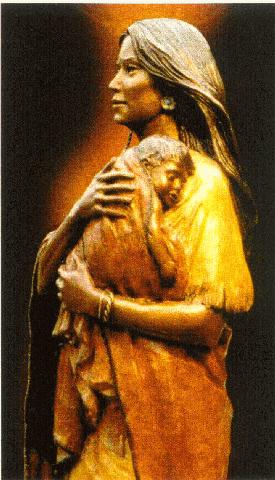Sacagawea
& Jean Baptiste
|

|
A near-legendary figure in
the history of the American West for her indispensable
role on the Lewis and Clark Expedition, Sacagawea has
become an enigma for historians seeking to trace her
later life. The daughter of a
Shoshone chief, Sacagawea was probably born in Idaho
around 1787. Sacagawea was kidnapped by the Hidatsa when
she was about ten years old and taken back to their
village on the upper Missouri. There, she and another
captive girl were purchased and wed by Toussaint
Charbonneau, a French Canadian trapper.
When Lewis and Clark engaged
Charbonneau as an interpreter for their expedition in
1804, it was with the understanding that Sacagawea would
also accompany them. Aside from her
|
value as an interpreter, they expected her mere
presence to speak well of them to Indians they would encounter
along the way. As Clark noted in his journal, "a woman with
a party of men is a token of peace."
Eight weeks before Lewis and Clark set out from
the upper Missouri, a second token of peace was added to the
expedition when Sacagawea gave birth to her first child, a son
named Jean Baptiste Charbonneau but called Pomp or Pompey by
Clark. Sacagawea carried her infant on a cradleboard as the
"Corps of Discovery" headed upriver in April, 1805.
Four months later, when the expedition had
reached the navigable limits of the Missouri, Lewis set out to
make contact with a Shoshone band, from whom he hoped to obtain
horses for their trek across the mountains. When Sacagawea
arrived to serve as interpreter, she found the band was led by
her older brother, Cameahwait, who had become chief on their
father's death. Deeply moved by this reunion, Sacagawea might
have taken advantage of such an astounding coincidence to return
to her people, but instead she helped the explorers secure the
horses they needed and journeyed on with them and her husband to
the Pacific.
On the return journey, Sacagawea and
Charbonneau parted with Lewis and Clark at a Hidatsa village on
the upper Missouri, and from this point the historical record of
their lives becomes somewhat conjectural.
Charbonneau evidently traveled to St. Louis at
the invitation of William Clark, who had grown fond of the young
Pompey and hoped he could induce his father to settle there.
After a brief trial, however, Charbonneau returned to trapping,
leaving his son in Clark's care. He worked for the American Fur
Company, and later accompanied Prince Maximillian on the
expedition that brought the artist Karl Bodmer to the upper
Missouri in 1833.
Whether Sacagawea accompanied Charbonneau to
St. Louis is uncertain. Some evidence indicates that she did make
this journey, then returned to the upper Missouri with her
husband where she died in an epidemic of "putrid fever"
on December 20, 1812. Other accounts say that Sacagawea
ultimately rejoined the Shoshone on their Wind River reservation
and died there in 1884.
